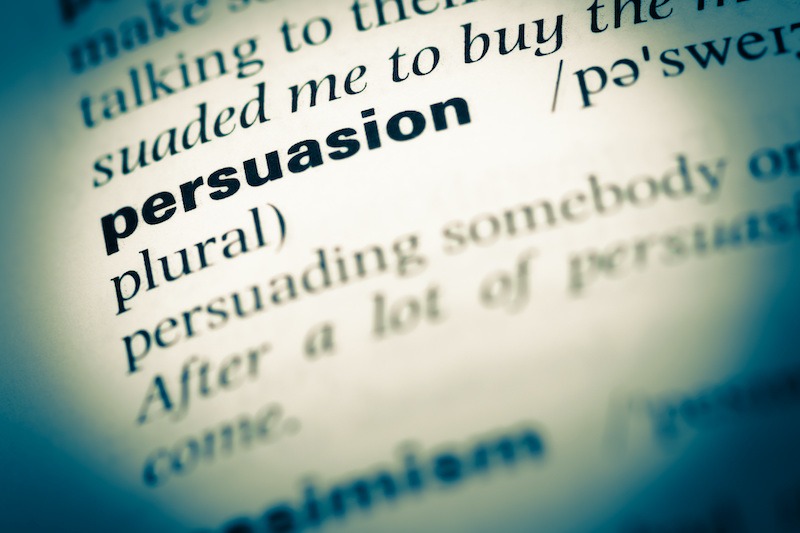What is the main reason you create an online platform for your business? I’m not talking about increasing your profile. And I’m not referring to making a pretty place for people to find you. What are you trying to get your visitors to actually DO?
If you have an online business, essentially, all you’re trying to do is get your visitors to say yes.
But here’s the thing. To get them to do that, you need to understand how they make decisions. And of course, while we all like to think we’re logical, our choices are usually and, in fact, always influenced deeply by our emotions.

So how does this play out when it comes to your copywriting in your content on your website?
Emotional persuasion is the key to improving your messaging as you can get more of your visitors to say yes.
In fact, research-driven emotional persuasion techniques can really rocket your conversions.
What does that mean? That you get way more people saying yes!
What Is Emotional Persuasion?
If you’re using emotional persuasion, you’re arousing emotion to influence your potential clients and customers, so they make a purchasing decision.
When it comes to online marketing, there are three different ways you can do this:
*Words
*The user experience
*Visuals
When these are successful, and you combine them all together, it stirs your visitors to action. That means that essentially they are more likely to buy from you.
Now, we all like to think that actually, as human beings, we’re entirely rational. That we have the power to make our own decisions.
When we hear this, we scoff: “I mean, seriously? Are you going to say to me, you can tell me how I’m going to do something, and why I will do it? AND they make me purchase something by using a technique?”
Actually, despite what you may think, in actual fact, we aren’t rational decision-makers at all. Nothing could be further from the truth.
Why We Can’t Make Rational Decisions
Remember, at the beginning of the coronavirus, when everybody was buying toilet rolls and kitchen towels? Leaving the shelves bare in the supermarket? Do you remember everybody panicking and scrambling to buy pasta and beans? It was like Armageddon had come! Hand sanitizer was in hot demand, and you couldn’t get toilet paper for love nor money. That, right there, demonstrates how buying behavior in us, as human beings, is often driven primarily by how we feel.
In the coronavirus case, it was because we were frightened and anxious and didn’t know what was going to happen. I mean, who actually came up with the idea that toilet roll was going to run out anyway? Did they ever say anything to us about us needing shed loads of toilet roll because of the coronavirus? Having a runny nose was never one of the symptoms.
Why Do You Need To Use Emotional Persuasion?
The common assumption is that we look at the information that changes our attitude. And then we change our behavior.
People tend to look for information that confirms how they feel about something. So if you give them information that goes against how they think, they often put it to the back of their mind. And they don’t take any notice of it. This is called confirmation bias by psychologists.
Even if you manage to change someone’s attitude, they still might not take any action. Here’s an example. While millions of people want to eat a healthy diet or stop drinking or smoking, they don’t actually ever do it. Why? Because they don’t have the right attitude. And this doesn’t translate into them changing their behavior.
This reaction actually highlights what psychologists have known for many years: we rely on our emotions to make our decisions.
How Emotional Persuasion Works
When we talk about emotion and marketing, we look at two different aspects.
Are you as the buyer experiencing a positive or negative emotion? Positive emotions are pride or happiness. While negative emotions are more like anger or fear. These are also called high valance and low valance emotions. This is where marketers look whether you’re experiencing an emotion intensely or mildly.
For example, anger or excitement can get you highly aroused. While sadness and amusement are low arousal emotions.
Another thing to understand about emotional persuasion is appraisal tendencies.
If someone is angry, they see the world through the eyes of being harmed by someone else. An angry person can usually feel a sense of certainty about what they’ve been through and a sense that they can act to address the offense they’ve suffered.
Fear also has appraisal tendencies. Suppose you’re assessing risk through fear and anger. In that case, if you have a fearful disposition, you’re more pessimistic about the outcome of the bet.
But if you’re angry, you have less concern about the risk.
Assessing value emotions can exert a massive influence on whether someone buys something. And this links into the selling prices of something in a buying situation.
How does that work? If you’re sad or miserable, you have a diminished sense of self. And then you have a willingness to pay higher prices for consumer products. Can you see where this is going? This all looks back into utilizing the pain points of somebody’s experience in selling your product.
Why You Need To Know Your Audience’s Emotional Profile
Emotion is messy and complicated. So you need to have a well-defined process for your audience and know exactly why you’re trying to persuade them. How can you convince them? You need to know everything you can about them, and you need to know what makes them tick.
What do they love and what don’t they like. What are their aspirations? Do they have goals and motivations? What inspires them, and what turns them off?
How do you do this?
Research. Talk to your audience, get case studies, and create a bank of voice of customer data you can draw from.
Use writing, wireframing, and editing. You’re bringing the copy together with an experience and a whole new coherent level by introducing this kind of research.
Use testing. Don’t just throw up new copy. You can use platforms like usertesting.com to give you more insight and understanding. Use split testing to see what resonates best.
Once you’ve got your process sorted out, you can sort your words, visuals, and how your user will experience it.
How Can Words Trigger Emotional Persuasion?
Did you know you can include trigger words into your copy – known as power words? These can make your copy more persuasive and invoke emotion.
Here are some examples and variations you can use:
Happiness: heartwarming, profound, inspiring, alive
Indulgence: guilt to guilt-free, obsessed
Precious: expensive, glamorous, luxurious
Humor: funniest, hilarious, ridiculous
Gravity: gargantuan, gigantic
Using these words means you can build connections with your readers to see their own journey in your comments.
Use storytelling to craft more powerful messaging; by placing your customers at the center of the story.
And use attentional bias and social proof to demonstrate you understand them and can solve their problems.
What Should You Ask Your Website Visitors?
Give your users an experience that resonates with them on every level.
Your user is asking questions like:
*Does this help me do what I want to get done?
*What makes things easy for me?
*What is unnecessarily complicated?
Take away the things they’re going to find an answer with a negative, and turn it into a positive.
Is your messaging clear, so can they read the copy above the fold? Is your site mobile responsive? If their experience is smooth and easy, it’s going to be a lot more enjoyable for your user, prompting them to purchase.
If you pull all this together, you will soon find that emotional persuasion can work in your favor. And you’ll be offering your visitors a captivating experience.
If you like this blog post, check out my other blog post on how to incorporate great case studies into your website copy.
And if you would like to check out how you can use emotional persuasion on your website, book a free brand message audit with me HERE now, valued at $500USD.



Recent Comments